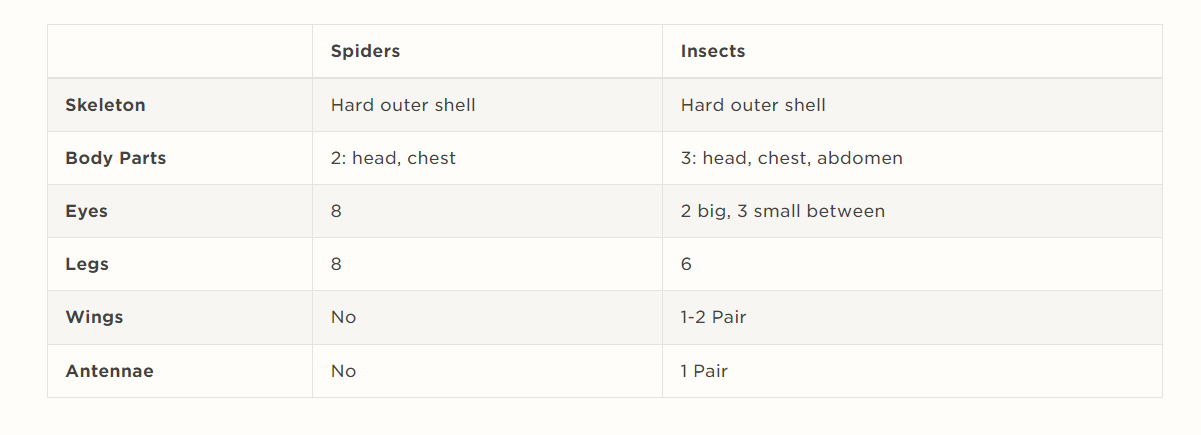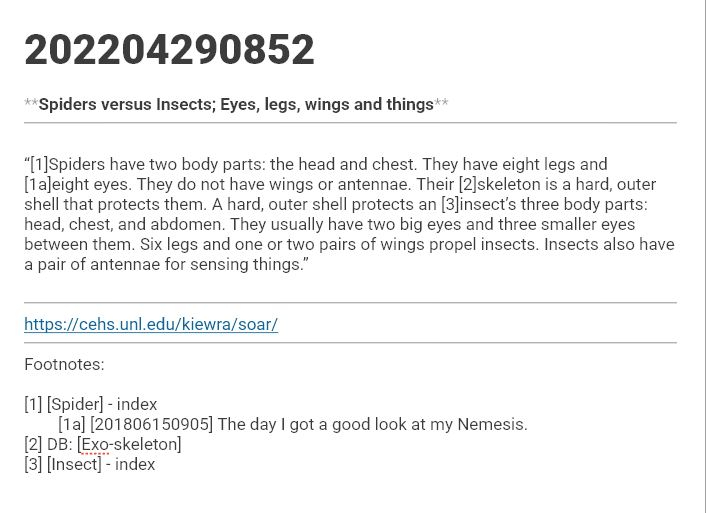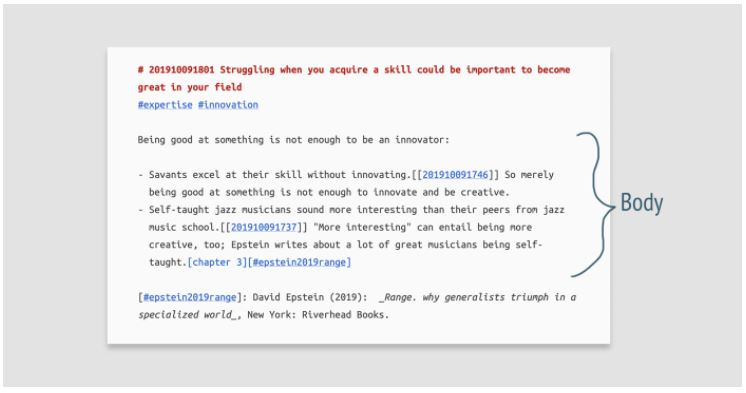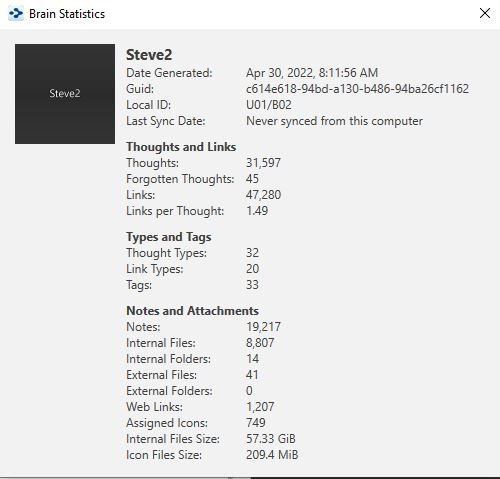Zettelkasten is hard for me, How can I turn this example to Zettelkasten , I use obsidian
Hello,
I am new to the Zettelkasten method, I read everything I could read and find about it. but it is still hard for me. I am a visual person I like to see visual representations of What I read. my method for learning is to organize info then make connections visually between them, and then I make a connection to my past experience, for example
this is a paragraph talking about spiders:
source: https://cehs.unl.edu/kiewra/soar/
Spiders have two body parts: the head and chest. They have eight legs and eight eyes. They do not have wings or antennae. Their skeleton is a hard, outer shell that protects them.
A hard, outer shell protects an insect’s three body parts: head, chest, and abdomen. They usually have two big eyes and three smaller eyes between them. Six legs and one or two pairs of wings propel insects. Insects also have a pair of antennae for sensing things.
my problem is about, How can I correctly apply Zettelkasten?
is this paragraph represent one note, one complete note? Should I make it smaller parts for every single detail?
How can I organize it in a matrix table? like this ![]()

when it comes to associating them with each other, Should I make links for the association?
when I make associations for what I know and make connections between new knowledge and previous knowledge, Should I make links?
Should I consider the whole thing one Zettelkasten note and make a template for my workflow?
I know I ask a lot because I feel lost
by the way, I use obsidian for note-taking.
Howdy, Stranger!
Comments
Hi, @mazin and welcome
This is normal to feel lost at first. Visual or not, every notes suppose to take note first
For example, in this case I would :
Did you read this section of the site : Getting Started ? It mays answer a lot of your questions first.
What do you want to accomplish with your Zettelkasten? What are your needs, except of visual notetaking? It is a very personal tool, it could brings you anywhere, from studies to personal knowledge, and fiction writing as well !
Short answer, yes. I view a new note as new knowledge, and an old note is previous knowledge. So it becomes essential to link new notes with old notes as ideas connect. As your note library grows, the activity of searching old notes to connect with new notes becomes invigorating. Connecting notes becomes a proxy for connecting new knowledge and previous knowledge.
Short answer, yes. This table may or may not grow. Suppose your field of study is entomology or arachnology. In that case, this might branch one way, and if your field of study is superhero animation, then your connections would branch a different way, or if your field of study is forestry, then this is probably enough. I'm not sure what you mean by "and make a template for my workflow?"
Will Simpson
My peak cognition is behind me. One day soon, I will read my last book, write my last note, eat my last meal, and kiss my sweetie for the last time.
My Internet Home — My Now Page
@mazin

Welcome to the world of Zettelkasten. Given your example, I like to utilize a "study format" in my Zettel notes. When technical information could be subject to rote memorization, I prefer the use of Footnotes to make connections, leaving the title as my only source of reformation. Here is how your example would look inside my Zettelkasten
Footnote 1: is a link that would take me to my keyword page for spiders. For me, keywords are broken down into three sections. First, a keyword definition; second, an index listing all Zettels with the keyword in the subject matter; and third, questions. I use questions as a capture point for structure notes.
Footnote 1a: you mentioned, "I make a connection to my past experience." I would do that while reading; if something catches my attention, especially a journal entry or personal prose, I create a link.
Footnote 2: DB stands for "developing blog" and is different from a keyword; here, I capture links for ideas that fascinate me and want to develop further.
Footnote 3: a link to another keyword.
There are many moving parts in this paragraph, and you will link and connect the items of interest to you and your project. Good luck.
@Steven625 Not to sound rude or anything, but that example looks like a lazy copy-paste that threw Atomicity out of the window. Not to mention that you didn't explicitly state why you placed the links.
@Annabella


In that case, I'll refer you to Sascha's blog article: https://zettelkasten.de/introduction/#putting-the-pieces-together
In which he gives an example of "The Body of the Zettel."
And I quote from the 2nd paragraph following that main heading "There is nothing wrong with capturing a verbatim quote on top."
In my example, I have a UID, a title, keywords, the verbatim quote, and reference; However, in some instances, not all, but more often than not, I link information I want to remember to something I already know. I don't always feel a need to break notes down to an atomic level, nor do I require of myself a reformation of every sentence. After all how many ways can you say "A spider has eight legs?" If I can connect new information via a footnote to the knowledge I am attempting to develop, good enough for me. My Zettelkasten hovers around 31,000 notes, I link, combine, delete and develop in the simplest way possible for my purposes.
@Steven625
You're missing the point.
The title leads you to believe that the Zettel is a comparison between spiders and insects. Instead, the content describes the anatomy of both but doesn't compare them. You'd expect to see something like OP's table in its place.
As for the links, it's not clear why you linked to the Zettels. How does your nemesis relate to a comparison of spiders and insects? And what about DB? Also, why would you link to keywords page?
Not many, but for cases like these, using an image and arrows would probably be good enough, like this.
@Annabella
This could very well be true.
At 31,000 notes, titles become almost meaningless; the relationship between information and the position of the note takes precedence.
This is also true to you or anyone else looking at my Zettelkasten; however, I managed to find an eleven-word quote regarding verbatim quotes that filled the need I intended in minutes among 1,126 notes on the keyword "Zettelkasten." My Zettelkasten work for me; I hope your's works for you.
It is fine for you, but the topic in hands here is "help I'm new to Zettelkasten and I don't understand what I can do to make my notes usefull".
Your notes being usefull for you is fine, but you don't help the OP, which should be your primary focus while answering such a topic.
@Loni
Then I will apologize directly to @mazin for illustrating something outside the standard approach—good luck, @mazin, in your pursuit of knowledge.
Maybe you could explain your choices to them ? Illustrating that many approaches exist is a good thing to keep in mind as well
@Loni
No thanks, I never did color inside the lines very well.
Thanks for chiming in, @Loni. You carried things really well.
And well done @Steve625 for how you handled the situation. I thought we were going to start a war or something, but you took the mature route. I meowtion this because I've dealt with immature people in the past and boy is it frustrating. That's what led meow to quit Discord.
I just hope that the OP looks at these comments. Sometimes, a user will start a discussion and people will comment on it, but the OP never says a thing. Regardless of why that might be, it leaves meow wondering whether they got the answer they were looking for.
I can understand Mazin's problem. I like The Archive and Zettels, but sometimes have to use a mind map (I use iThoughts) to structure things. Then, sometime, I then paste them into Zettels. I too like visuals...
Thank you
Thank you
Thank you
Thank you
Thank you
@mazin Good to see that you found everyone's advice helpful. /ᐠ. ᴗ.ᐟ\ I hope that you have a fur-tunate journey!
@mazin
Comparing Spiders to Insects
/#Spider-Anatomy
Insight: No. Spiders are not insects. While spiders and insects are distant ancestors, they are not the same type of animal. Both insects and spider are invertebrates [[202003040356]] with an exoskeleton [[201930453456]], though there are a handful of characteristics that set insects apart from spider.
Spiders vs. Insects
Further Research
Later on I would put a link next to legs, wings, or antennae that goes to a note explaining why there is this difference in feature between spiders and insects (e.g. [[202104231932]]).
@Steve625 Why do you put the links as footnotes instead of just next to the word or what not? (never thought to do that, may give it a try)
@Nick
I always capture the quote and reference from every source. Footnotes allow me to re-read the original quote without all my thoughts jumbled in; I do this primarily for four reasons.
First, I use the barbell method of reading; therefore, I capture thoughts and ideas in bulk. If it catches my eye while reading, I capture it for processing.
Second, during processing, as I attempt to reach the atomic idea of the note if the idea is a reformulation from the current author to an existing Zettel. I add a footnote and connect via link to my original atomic thought. I've already done the work, in another location; therefore I want the link to tie into an existing thread. If the atomic idea is unique, then I create a footnote and write my own reformation of the atomic idea.
Third, when processing, I create footnotes to other things that come to mind. Sometimes a footnote will say "beautiful wording," sometimes a question, or mark an insight. If another atomic thought presents itself, I know where to split the note into more than one zettel.
Fourth, footnotes to keywords if the note actually explains something unique to the keyword.
An example using footnotes with your links:
In my note (I actually don't have a single note about spiders and my above example caused confusion) I would have a footnote for [1]invertebrates and [2]exoskeleton in the original quote. The footnote [1] & [2] would cross-reference to another zettel note i.e, [202003040356] in your example, containing additional information on invertebrates or exoskeleton. I often footnote a link to the definition if the word is new to me, or I use a footnote to mark the spot where I have reformulated thoughts into my own words.
I started using footnotes, when I had trouble connecting what had caused the original inspiration with my written prose about the insight.